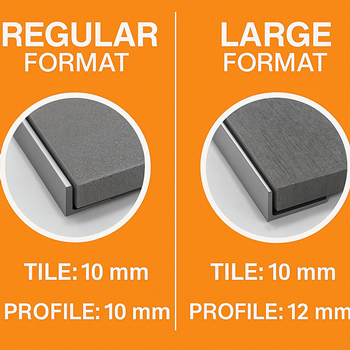10mm vs 12mm Tile Trims | How to Choose Tile Edging
6th Jul 2025
10mm vs 12mm Tile Trims: How to Choose the Right Tile Edging
Choosing the correct tile trim thickness is key to achieving a clean, professional finish. The most commonly used options are 10mm and 12mm tile trims, and while they may seem similar, selecting the wrong size can lead to uneven edges or weak finishes.
This guide explains the difference between 10mm and 12mm tile edging, how to measure correctly, and which is best for your project — whether it’s a small bathroom or a commercial floor installation.
What Is a Tile Trim?
Tile trims (or tile edging profiles) are protective strips installed at the exposed edges of tiles to prevent chipping, seal corners, and create a smooth transition. Available in materials like aluminium, stainless steel, brass, and PVC, trims also come in various depths to suit your tile thickness.
Tile Trim Thickness: 10mm vs 12mm Explained

10mm Tile Trims
- Fits tiles up to 10mm thick, including most ceramic and standard porcelain tiles.
- Commonly used in kitchens, bathrooms, and walls with regular-sized tiles.
- Creates a subtle, minimalistic edge appearance.
12mm Tile Trims
- Designed for tiles up to 12mm thick, such as stone, slate, or large format porcelain.
- Offers better protection for heavy-duty or high-traffic installations.
- Ideal for commercial floors, outdoor tiling, or feature areas with thicker materials.
How to Choose the Right Tile Trim Thickness
- Measure Tile Thickness Accurately: Use a caliper or measuring tape. Don’t forget to factor in adhesive depth.
- Consider Tile Type: Natural stone or extra-large porcelain tiles often require 12mm trims.
- Match the Look: 10mm offers a slimmer, cleaner finish, while 12mm gives a bolder profile.
- Location Matters: Areas like floors and external corners benefit from thicker edge protection.
The trim depth should slightly exceed the tile thickness + adhesive layer to prevent overhang or recession. When in doubt, choose a slightly larger trim for a flush finish.
Installation Tips for Tile Trims
- Always test-fit trims before applying adhesive.
- Use a mitre saw or fine-toothed hacksaw for clean corner cuts.
- Ensure trims are level and flush with tile surfaces before setting.
Popular Tile Trim Materials (Available in 10mm & 12mm)
- Aluminium Trims – Lightweight and cost-effective.
- Stainless Steel Trims – Durable and corrosion-resistant.
- Brass Tile Trims – Elegant and long-lasting.
- Formable (PVC) Trims – Flexible and easy to cut, great for curves.
Why Choose National Tile Trims?
We stock a wide selection of straight edge tile trims in 10mm and 12mm sizes. Whether you’re finishing wall tiles in a small bathroom or protecting floor tiles in a busy commercial space, our range has you covered.
Explore our expert resources like The Ultimate Guide to Tile Trims for deeper insights.
FAQs About Tile Trim Thickness
What size tile trim should I use?
Match the tile trim size to the thickness of your tile plus adhesive — usually 10mm for standard tiles and 12mm for thicker or large format tiles.
Can I use 12mm trim for 10mm tiles?
It's not recommended. You may get a recessed edge or exposed adhesive unless filled carefully. Always try to match trim size closely to tile depth.
What happens if I use the wrong trim size?
Too small and the tile won’t fit; too large and the edge may look untidy or collect dirt. Accurate measuring is key to a flush, clean finish.
Is tile edging really necessary?
Yes — trims protect tile edges from chipping, water damage, and wear. They also enhance the visual appeal of the finish.
Final Thoughts
Whether you need a 10mm tile trim for standard ceramic tiles or a 12mm edging profile for heavy-duty porcelain, the right choice will make your tiling project look sharp and last longer. Take the time to measure accurately and pick the material that suits your space.
Ready to find the perfect tile edge trim?
Browse our tile edging range or speak to our team for tailored advice.
